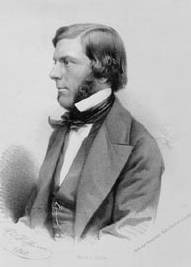Chem 220a
Problem Set 8
Chapter 9
Due: Monday, November 1, 1999
|
1) The Alkyne module in ORGO will be a big help to you:
https:// classes.yale.edu/chem220a/
studyaids/index/index.html.
2 Diethyl ether can be prepared by an SN2 reaction
between sodium C2H5ONa and ethyl bromide
in ethanol (Williamson ether synthesis). When
(E)-4-octene (A) reacts with Cl2/H2O,
compound B (C8H17ClO) is formed. When B
reacts with potassium tert-butoxide, B is
converted into C (C8H16O) and tert-butyl
alcohol D. What are the structures of B and C.
Explain the steps and pay attention to
stereochemistry. [10/20 lecture]
|

Alexander Williamson
1824-1904
|
3) When (R)-6-methyl-3-octyne (1) is heated with NaNH2, a
base-catalyzed rearrangement occurs
(p. 395) producing the sodium salt of a terminal acetylene,
optically active (R)-1-sodio-6- methyl-1-octyne (2). Addition of
water to 2 provides (R)-6-methyl-1-octyne (3). Your text (p.395)
states
that an internal acetylene, which is more stable* than a terminal
acetylene, is usually formed when KOH at
200 oC is used in such a rearrangement. Yet when NaNH2 is
employed, the terminal alkyne and not the
internal alkyne is formed. This reaction is driven by the
irreversible formation of 2. Compare
[https://classes.yale.edu/chem220a/ studyaids/pKa.html] the pKa's
of water, a terminal acetylene and NH3
to explain these results. The acetylene group, i. e., the triple
bond, does not migrate to the other end of the
carbon chain to produce ultimately 3-methyl-1-octyne (4). Why?
[Hint: Think about what would happen
at the stereogenic carbon if the rearrangement occurred in this
direction to produce terminal alkyne 4.] [* --
> Compare the heats of formation of 1-butyne and 2-butyne. Note
that they are both less stable than their
respective elements.
https://classes.yale.edu/chem220a/studyaids/thermo/heats-formation.html]
4) In problem 3, two optically active, diastereomeric allenes,
6-methyl-2,3-octadiene, serve as intermediates
in the conversion of alkyne 1 (in problem 3) to a second alkyne A,
(R)-6-methyl-2-octyne, before 2
(problem 3) is formed. Explain and illustrate. [See,
https://classes.yale.edu/chem220a/studyaids/isomers
/isom_intro/isomer.html and/or p. 199 for additional help.]
5) An unknown compound A (C6H10) reacts with Li/NH3 to form B
(C6H12). Ozonolysis and dimethyl
sulfide reduction of compound B affords only n-propionaldehyde C.
Treatment of B with Br2 in CCl4 gives D
while OsO4 oxidation of B gives E. What are the structures of A-E?
Show your reasoning; pay attention
to stereochemistry.
6) Design a synthesis of meso-3,4-hexanediol. Acetylene and
ethylene are the only sources of carbon
available to you. All reagents are available.
7) An optically active compound A (C6H13Br) reacts with C2H5ONa in
C2H5OH to form a single
compound (E)-B, C6H12. Ozonolysis of B forms an aldehyde (not
formaldehyde) C and the only C4
ketone D. What are the structures of A-D? [You will not be able to
determine which enantiomer of A it
is.]
8) Our mutual friend*, Dr. Knowitall, decides to prepare only
2-octanone from 2-octyne by hydration in the
presence of stoichiometric HgSO4. What two pieces of advise do you
have to offer him/her? [Hint: If
you're stumped and haven't read the Alkyne module in ORGO, now
would be a good time.]
* Not to be confused with Charles Dickens's, "Our Mutual Friend".
Dickens did make the following
observations about our fair city in his "American Notes" during
his visit in 1842.
New Haven, known also as the City of Elms, is a fine town. Many of
its streets (as its alias sufficiently
imports) are planted with rows of grand old elm-trees; and the
same natural ornaments surround Yale
College, an establishment of considerable eminence and reputation.
The various departments of this
Institution are erected in a kind of park or common in the middle
of the town, where they are dimly visible
among the shadowing trees. The effect is very like that of an old
cathedral yard in England; and, when
their branches are in full leaf, must be extremely picturesque.
Even in the winter-time, these groups of
well-grown trees, clustering among the busy streets and houses of
a thriving city, have a very quaint
appearance: seeming to bring about a kind of compromise between
town and country; as if each had met
the other half-way, and shaken hands upon it; which is at once
novel and pleasant.
[http://wsrv.clas.virginia.edu/~jlg4p/dickens/amnotes/dkstc.html]